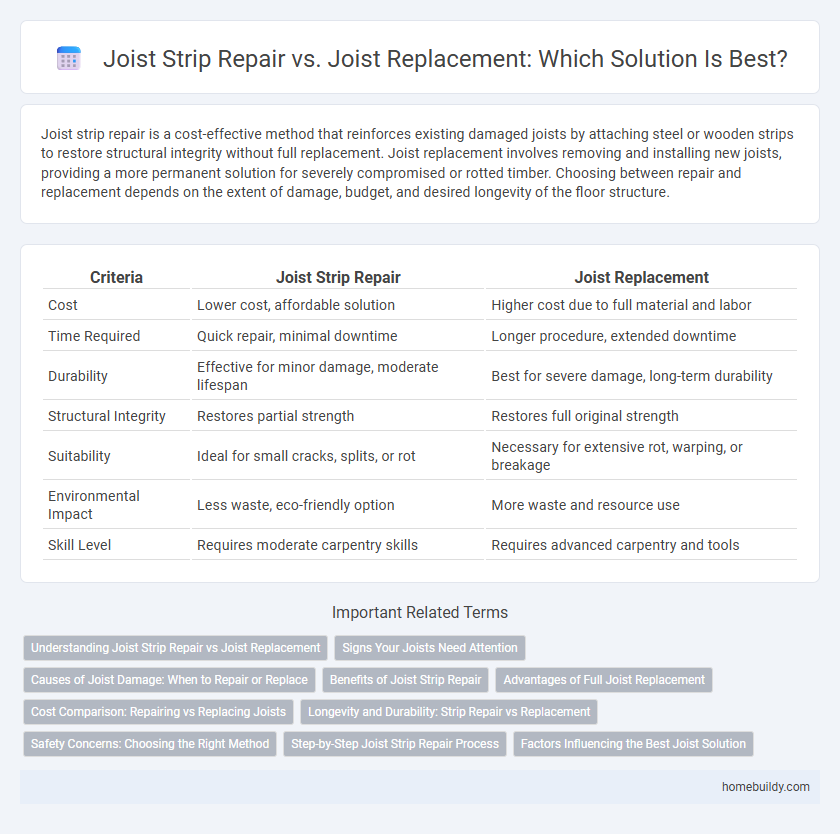Joist strip repair is a cost-effective method that reinforces existing damaged joists by attaching steel or wooden strips to restore structural integrity without full replacement. Joist replacement involves removing and installing new joists, providing a more permanent solution for severely compromised or rotted timber. Choosing between repair and replacement depends on the extent of damage, budget, and desired longevity of the floor structure.
Table of Comparison
| Criteria | Joist Strip Repair | Joist Replacement |
|---|---|---|
| Cost | Lower cost, affordable solution | Higher cost due to full material and labor |
| Time Required | Quick repair, minimal downtime | Longer procedure, extended downtime |
| Durability | Effective for minor damage, moderate lifespan | Best for severe damage, long-term durability |
| Structural Integrity | Restores partial strength | Restores full original strength |
| Suitability | Ideal for small cracks, splits, or rot | Necessary for extensive rot, warping, or breakage |
| Environmental Impact | Less waste, eco-friendly option | More waste and resource use |
| Skill Level | Requires moderate carpentry skills | Requires advanced carpentry and tools |
Understanding Joist Strip Repair vs Joist Replacement
Joist strip repair involves reinforcing existing wooden joists by attaching metal strips or sister boards to address minor damage and enhance structural support. Joist replacement requires removing and substituting severely damaged or rotted joists to restore the integrity of the floor or deck system. Choosing between repair and replacement depends on the extent of deterioration, load-bearing requirements, and long-term durability considerations.
Signs Your Joists Need Attention
Signs your joists need attention include visible cracks, sagging floors, or excessive deflection under weight, indicating structural weakness. Moisture damage, rot, or insect infestation can compromise joist integrity, requiring immediate inspection. Joist strip repair is suitable for minor damage, while extensive decay or structural failure necessitates full joist replacement for safety.
Causes of Joist Damage: When to Repair or Replace
Joist damage often arises from wood rot, insect infestation, water exposure, or structural overload, each affecting the integrity and load-bearing capacity differently. Repairing a joist strip is suitable when damage is localized, such as minor rot or small cracks, allowing for reinforcement without full replacement. Extensive damage involving significant decay, twisting, or compromised structural stability necessitates joist replacement to ensure safety and longevity of the building framework.
Benefits of Joist Strip Repair
Joist strip repair preserves the structural integrity of wooden beams by reinforcing damaged sections without the need for complete replacement, significantly reducing material and labor costs. This method minimizes disruption to the building's framework, allowing for faster project completion and less invasive work compared to full joist replacement. Joist strip repair also extends the lifespan of existing joists by addressing localized damage, maintaining overall support while avoiding unnecessary waste.
Advantages of Full Joist Replacement
Full joist replacement offers superior structural integrity compared to joist strip repair by fully restoring load-bearing capacity and eliminating hidden damage. This method ensures long-term durability and safety, reducing the risk of future costly repairs or structural failures. Complete replacement also provides an opportunity to upgrade materials, improving resistance to moisture, pests, and environmental wear.
Cost Comparison: Repairing vs Replacing Joists
Repairing joist strips typically costs between $100 and $500 depending on the extent of the damage and materials required, offering a cost-effective solution when damage is minor. Joist replacement, however, can range from $1,000 to $3,000 or more, reflecting labor intensity and the need for new structural components. Choosing repair over replacement significantly reduces expenses while maintaining structural integrity when damage is limited to surface-level or partial deterioration.
Longevity and Durability: Strip Repair vs Replacement
Joist strip repair extends the lifespan of existing joists by reinforcing weakened areas, providing a cost-effective solution with moderate durability suited for minor damage. Joist replacement involves removing and installing new joists, offering superior longevity and structural integrity ideal for severe deterioration or extensive rot. Choosing replacement ensures maximum durability, while strip repair balances immediate reinforcement with budget considerations.
Safety Concerns: Choosing the Right Method
Joist strip repair enhances structural integrity by reinforcing weakened sections without compromising overall support, reducing the risk of sudden failures. Joist replacement, although more invasive, ensures long-term safety by completely removing damaged wood that could harbor rot or insect damage. Evaluating load capacity, extent of damage, and moisture levels determines the safest and most effective method for joist repair or replacement.
Step-by-Step Joist Strip Repair Process
Joist strip repair involves securing damaged joists by attaching a new strip of wood or metal along the weakened section, restoring structural integrity without full replacement. The step-by-step repair process begins with assessing the extent of damage, cleaning the area thoroughly, and cutting a joist strip to fit precisely over the compromised section. Next, the strip is fastened using construction adhesive and corrosion-resistant screws or bolts, followed by sealing and reinforcing to ensure long-term stability and load-bearing capacity.
Factors Influencing the Best Joist Solution
Factors influencing the best joist solution include the extent of damage, structural integrity, budget constraints, and project timeline. Joist strip repair is ideal for minor rot or localized damage, preserving most of the existing joist while enhancing strength and stability. Joist replacement is necessary for severe decay, extensive splitting, or compromised load-bearing capacity, ensuring long-term safety and durability.
Joist strip repair vs Joist replacement Infographic

 homebuildy.com
homebuildy.com